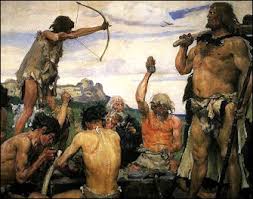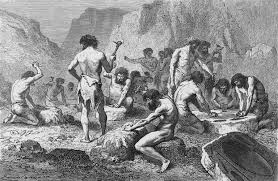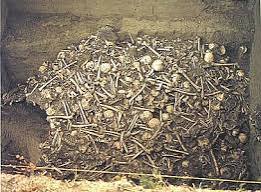Within each of us lies a staggering 3.16 billion base pairs of DNA, encoding not only our genetic blueprint but also the deepest secrets of our biological history. Among these secrets, scientists have uncovered chilling evidence of a brutal, widespread conflict that shaped the genetic landscape of humanity. This forgotten war, largely unknown to most, represents perhaps the first truly global conflict, spanning much of the known world and leaving an indelible mark on human DNA.

The Genetic Bottleneck: A Clue to Catastrophe.
Recent genetic studies have revealed a dramatic bottleneck in human history—a period during which genetic diversity plummeted. While population bottlenecks are not uncommon, often occurring due to natural disasters or disease, this particular event was unique in that it almost exclusively affected males. By analyzing modern human genomes, researchers discovered a significant reduction in Y-chromosome diversity, indicating that the male population experienced a catastrophic decline.This event, occurring around 5,000 to 7,000 years ago during the late Neolithic period, suggests that up to 95% of the male population across Europe, Asia, the Middle East, and Africa perished. If such an event were to happen today, it would equate to the loss of approximately 3.9 billion men, leaving only 200 million survivors. The sheer scale of this disaster surpasses even the bloodiest wars in recorded history and suggests an unprecedented level of sustained violence.

The Evidence: Mass Graves and Violent Deaths.
Skeletal remains from this period provide further support for the theory of widespread violence. Over 250 Neolithic mass graves have been discovered across Europe alone, with many containing the remains of individuals who suffered violent deaths. Analyses of these remains paint a grim picture of the era:- A study of 2,300 early farmers found that more than 10% bore injuries consistent with weapon strikes, likely from raiding parties.- Another study of 138 individuals in Spain revealed that 23% had suffered violent trauma, with adolescent and adult males disproportionately affected.- Many victims exhibited blunt force trauma, arrow wounds, and signs of ritualistic execution, suggesting large-scale massacres rather than mere skirmishes.Among the most horrifying discoveries is the Talheim Death Pit in Germany, dating to around 5,000 BC.

Here, researchers unearthed the remains of at least 34 individuals who had been brutally slain. Notably, none bore defensive wounds, indicating they were fleeing rather than fighting. The victims included men, women, and children, with many suffering fatal head wounds, a hallmark of targeted execution.

The Scale of the Carnage: Widespread Massacres.
Other mass graves tell similar stories of indiscriminate slaughter:- “Schletz, Austria (5000 BC):
https://en.wikipedia.org/wiki/Massacre_of_Schletz
A settlement attacked and its population decimated, with over 200 victims dumped into a mass grave. Young women and children were conspicuously absent, likely taken as captives.

“Herxheim, Germany (5300-4950 BC):” Perhaps the most gruesome site, this settlement contained over 1,000 victims, their bodies systematically dismembered, defleshed, and cannibalized. Many skulls were split and displayed, suggesting ritualistic practices.

“Asia’s Headhunters and Mutilators” : Evidence from across the Neolithic world suggests that different cultures engaged in brutal warfare, from headhunting in Asia to the systematic mutilation of captured enemies.

“Crow Creek Massacre (South Dakota, USA – 1325 AD) : Though occurring much later, this massacre of nearly 500 individuals provides a chilling parallel to Neolithic violence, showing that large-scale communal warfare existed across different continents and time periods.

Why Did This Happen? Theories Behind the BloodshedThe cause of this unprecedented violence remains a subject of debate, with several theories proposed:
1.The Neolithic Revolution:
The shift from hunter-gatherer societies to settled farming communities created new conflicts. Agricultural settlements provided food, resources, and women in fixed locations, making them prime targets for raids. Additionally, growing populations led to competition for land and resources, further fueling conflict.
2. Patrilineal Warfare:
Some researchers suggest that as societies became more structured, male-dominated kin groups emerged, leading to constant inter-clan warfare. This would explain the sharp decline in Y-chromosome diversity while female mitochondrial DNA remained largely unaffected.
3. Gradual Genetic Drift:
A more peaceful hypothesis argues that the bottleneck resulted from the natural division and extinction of male lineages over time, rather than outright warfare. However, this theory struggles to explain the widespread evidence of massacres and systematic killings.
4. Climate Change and Resource Scarcity:
Environmental shifts could have led to food shortages, forcing communities into violent confrontations over dwindling resources. Archaeological evidence from this period suggests increased fortification of settlements, indicating rising insecurity and competition.
The Aftermath: A World Transformed.
Despite the staggering loss of life, humanity eventually recovered. As civilizations grew, trade and diplomacy emerged, and large-scale violence gradually subsided. While wars continued throughout history, they were often less universal in scale. The emergence of governance, social structures, and the rule of law reduced the frequency of total societal collapse due to warfare. Today, we live in an era of relative peace compared to the Neolithic world. Our lifespans have tripled, and conflicts are more often resolved through diplomacy rather than brute force. However, the genetic scars of this ancient war remain, serving as a silent reminder of humanity’s violent past.
The Legacy: What This Means for Us Today.
The story of this forgotten war is more than just a grim chapter in human history—it is a testament to our resilience. The genetic imprints of this conflict are still present in modern populations, influencing genetic diversity, social structures, and even aspects of human psychology.By studying these ancient conflicts, we gain insight into the forces that shaped civilization. Understanding our past may help us prevent similar large-scale conflicts in the future. As we advance in technology, governance, and diplomacy, we must remember the lessons of our ancestors: cooperation, adaptation, and the pursuit of peace are the ultimate keys to survival.While we may never fully understand what transpired during this dark chapter of prehistory, one thing is certain: our ancestors lived through an age of unimaginable brutality, and their survival paved the way for the world we inhabit today. The echoes of this ancient struggle remain etched in our very DNA, a hidden history of a war that shaped the destiny of humankind.
Thank you for reading, until next time!
